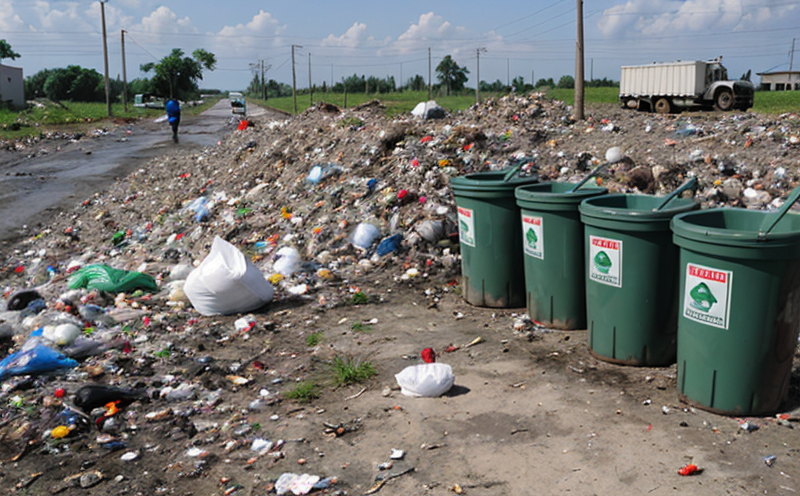EPA 8081 Organochlorine Pesticides in Solid Waste Test
The EPA Method 8081 is a critical standard used to quantify organochlorine pesticides in solid waste samples. This method has been designed with precision and reliability, ensuring that the data generated can be trusted for regulatory compliance purposes.
Organochlorines are a class of persistent organic pollutants (POPs) notorious for their long-lasting presence in the environment. They include compounds like DDT, chlordane, and hexachlorocyclohexanes. These pesticides were widely used until the 1970s but have been banned or restricted due to their severe environmental impacts.
The EPA 8081 method uses liquid-liquid extraction followed by gas chromatography with mass spectrometric detection (GC/MS). This technique allows for the accurate determination of even trace amounts of these pesticides in solid waste. The method is robust and reliable, making it suitable for both routine monitoring and research applications.
The primary objective of this test is to ensure that solid waste does not contain hazardous levels of organochlorine pesticides. This is crucial for protecting public health and the environment from potential contamination risks associated with these toxic compounds.
The process involves several key steps:
- Sample collection: Solid waste samples are collected in a manner that ensures they represent the entire batch of material being tested.
- Preparation: The collected samples undergo extraction using hexane to dissolve any organochlorine pesticides present. This step is critical for ensuring accurate quantification.
- Analysis: The extracted solution is then analyzed using GC/MS, which provides a high level of sensitivity and specificity in identifying the target compounds.
The method's precision and accuracy are further enhanced by strict adherence to EPA Method 8081 guidelines. This includes the use of certified reference materials (CRMs) for calibration and quality control checks throughout the process. The CRM ensures that the instrument's response is consistent, thus providing reliable results.
| Organochlorine Pesticide | Common Sources of Contamination | Health Risks |
|---|---|---|
| Pesticide use, discarded materials containing pesticides | Carcinogenicity, neurotoxic effects | |
| Wood preservation, pesticide application | Nerve and liver toxicity | |
| Pesticide use, discarded materials containing pesticides | Carcinogenicity, neurotoxic effects |
Industry Applications
The EPA 8081 method finds extensive use across various industries that handle or process solid waste. Key sectors include:
- Municipal Solid Waste (MSW) management: Ensuring compliance with regulations regarding hazardous materials in MSW.
- Recycling facilities: Monitoring for contamination from banned pesticides during the recycling and repurposing of materials.
- Industrial waste disposal: Checking for any potential release of organochlorine pesticides into the environment through improper disposal practices.
- Agricultural waste management: Verifying that agricultural by-products do not contain residues of banned pesticides.
Why Choose This Test
Selecting the EPA 8081 method for organochlorine pesticide testing offers several advantages:
- Regulatory Compliance: Adherence to this method ensures that your waste management practices are compliant with strict environmental regulations.
- Precision and Accuracy: The method uses advanced GC/MS technology, providing highly accurate quantification of organochlorine pesticides.
- Trusted Results: Certified laboratories using this method generate data that is widely accepted in regulatory circles for decision-making purposes.
- Cost-Effective: By ensuring compliance upfront, you avoid costly fines and penalties associated with non-compliance.
- Risk Mitigation: Early detection of organochlorine residues helps mitigate potential risks to human health and the environment.
Use Cases and Application Examples
The EPA 8081 test is particularly useful in scenarios where solid waste contains or may have been contaminated with organochlorine pesticides. Here are some real-world applications:
| Use Case | Description |
|---|---|
| Municipal Landfill Monitoring | Regular monitoring of landfill content to ensure compliance with environmental regulations. |
| Recycling Plant Waste Screening | Detecting banned pesticides in recycled materials to prevent contamination and ensure safe reuse. |
| Agricultural Waste Disposal | Checking for pesticide residues in agricultural waste before disposal or repurposing. |
| Pesticide Manufacturer Compliance | Verifying that by-products of pesticide manufacturing do not contain harmful levels of organochlorines. |
| Incineration Plant Emissions Control | Monitoring emissions to ensure they do not release organochlorine pesticides into the atmosphere. |





